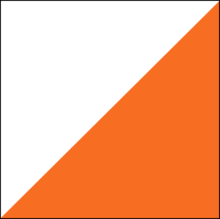Foot orienteering
|
The international orienteering symbol | |
| Highest governing body | International Orienteering Federation |
|---|---|
| First played | 28 May 1893, Stockholm, Sweden |
| Characteristics | |
| Contact | Non-contact |
| Team members | Individual |
| Mixed gender | Separate categories |
| Type | Outdoor |
Foot orienteering (foot-O) is the oldest formal orienteering sport, and the one with the most "starts" per year. Usually, a foot-O is a timed race in which participants start at staggered intervals, are individually timed, and are expected to perform all navigation on their own. The control points are shown on the orienteering map and must be visited in the specified order. Standings are determined first by successful completion of the course, then by shortest time on course.
Foot-O is one of four orienteering sports governed by the International Orienteering Federation.
History
The history of orienteering begins in the late 19th century in Sweden, the actual term "orienteering" was first used in 1886 and meant the crossing of unknown land with the aid of a map and a compass.[1] The first orienteering competition open to the public was held in Norway in 1897.[1] Notable dates for member nations of the IOF are shown below.
| First public event | National body founded | First national championships | First international event | Other | |
|---|---|---|---|---|---|
| Norway | 1897 | 1945 (NOF) | 1937 (Årnes/Kongsvinger) | 1932[1] (Slora, Sørkedalen) | |
| Sweden | 1901[2] | (SOFT) see below | 1935[2] (Skinnskatteberg) or 1937[3] | ||
| The first Swedish national body was formed in 1935,[3] [or 1936[2]] to co-ordinate both foot and ski orienteering. In 1938 SOFT took over the sport for all foot races.[2][3] | |||||
| Finland | 1923[4] (1904[4]ski orienteering) | 1935[4] | 1935 (Vihti) | ||
| Estonia | 1926 (Pirita) | 1959 | 1959 (Nelijärve) | 1973 (1969 ski orienteering) | |
| Australia | (OA) | ||||
| Canada[5] | 1967 (COF) | 1968 (Gatineau Park) | 1976? | ||
| India | (OFI) | ||||
| Ireland | 1969 | (IOA) | 1975 | ||
| Italy | 1976 (Ronzone)[6] | 1986 (FISO) | 1986 | 1993 (Kastelruth - JWOC) | |
| New Zealand | (NZOF) | ||||
| South Africa | 1981? | (SAOF) | |||
| UK[3][7] | 1962 | 1967 (BOF) | 1967 (Hamsterley Forest) | 1976 (Darnaway Forest) | |
| US | 1967 (Valley Forge, PA) | 1971 (USOF) | 1970 (Southern Illinois) | 1986 (Hudson Valley - World Cup) | |
| Russia/USSR | 1959 (Leningrad) | 1961 | 1963 (Uzgorod) | ||
International championships
- World Orienteering Championships
- Junior World Orienteering Championships
- European Orienteering Championships
References
- 1 2 3 "Past & present". International Orienteering Federation. Retrieved 2008-09-28.
- 1 2 3 4 "Milstolpar i utvecklingen" (in Swedish). Svenska Orienteringsförbundet. Archived from the original on 26 September 2007. Retrieved 2008-11-06.
- 1 2 3 4 Disley, John (1978). Orienteering. London: Faber & Faber. ISBN 0-571-04930-3.
- 1 2 3 "Historia | Suomen Suunnistusliitto". www.suunnistusliitto.fi. Retrieved 2016-05-28.
- ↑ Canadian Orienteering Federation (Retrieved on 10 October 2008)
- ↑ FISO, Italian Federation website
- ↑ http://www.athleticscholarships.net/other-sports-orienteering-3.htm(Retrieved on 14 October 2008)


